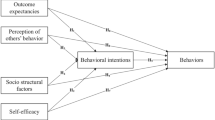Abstract
Farmers in a southwestern Ontario watershed were surveyed to determine factors influencing their attitudes towards adoption of soil conservation practices. The majority of farmers in the watershed were internally motivated which indicates they believe that their own actions determine their successes and failures. Most respondents were also environmentally oriented. However, although many farmers in the study area have adopted crop rotations and cross-slope tillage, the adoption rate of conservation tillage is low. The survey suggests that the low adoption rate may be more a function of perceived economic risk associated with the tillage practice than lack of farmer motivation.
Similar content being viewed by others
References
Baffoe, J.K., D.P. Stonehouse, and B.D. Kay. 1986. A Methodology for Farm-level Economic Analysis of Soil Erosion Effects Under Alternative Crop Rotational Systems in Ontario.Canadian Journal of Agricultural Economics 35: 55–73.
Battiston, L.A., M.H. Miller, and I.J. Shelton. 1987. “Soil Erosion and Corn Yield in Ontario. I. Field Evaluation.Canadian Journal of Soil Science 67: 731–745.
Bos, A.W. and J.S. Richards. 1983.Conservation Tillage Assessments. Stratford-Avon River Environmental Management Project, Technical Report R-12, 64 pp.
Christensen, L.A. and P.E. Norris. 1983. Soil Conservation and Water Quality Improvement: What Farmers Think.Journal of Soil and Water Conservation 38: 15–20.
Corsini, R.J. (ed.). 1984.Encyclopedia of Psychology. Vol. 1. Toronto: John Wiley and Sons, Inc. 481 pp.
Culver, D. and R. Seecharan. 1986. Factors that Influence the Adoption of Soil Conservation Technologies.Canadian Farm Economics 20: 9–13.
Dickey, E.C., P.T. Jasa, B.J. Dolesh, L.A. Brown, and S.K. Rockwell. 1987. Conservation Tillage: Perceived and Actual Use.Journal of Soil and Water Conservation 42: 431–434.
Dumanski, J., D.R. Coote, G. Lucuik, and C. Lok. 1986. Soil Conservation in Canada.Journal of Soil and Water Conservation 41: 204–210.
Ervin, C.A. and D.E. Ervin. 1982. Factors Affecting the Use of Soil Conservation Practices: Hypotheses, Evidence and Policy Implications.Land Economics 58: 277–292.
Fortin, M. 1982.Cropping-income Impacts of Management Measures to Control Soil Loss. Stratford-Avon River Environmental Management Project, Technical Report R-18, 18 pp.
Green, G.P. and W.D. Heffernan. 1986. Government Programs for Soil Conservation: Progressive or Regressive Effects?Environment and Behavior 18: 369–384.
Ketcheson, J.W., T.J. Vyn, and T.B. Daynard. 1983.Tillage Practices for Residue Management and Erosion Control. Agdex 100/516. Toronto: Ontario Ministry of Agriculture and Food.
Ketcheson, J.W. and D.P. Stonehouse. 1983. Conservation Tillage in Ontario.Journal of Soil and Water Conservation 38: 253–254.
Kramer, R.A., W.T. McSweeny, and R.W. Stavros. 1983. Soil Conservation with Uncertain Revenues and Input Supplies.American Journal of Agricultural Economics 64: 694–702.
Leopold, A. 1949. The Land Ethic. InManaging Canada's Renewable Resources, edited by R.R. Krueger and B. Mitchell. 1977. Agincourt, Ontario: Methuen Publications. pp. 41–42.
Lovejoy, S.B. and T.L. Napier. 1986. Conserving Soil: Sociological Insights.Journal of Soil and Water Conservation 41: 304–308.
McNairn, H.E. and B. Mitchell. 1991. Farmers' Perceptions of Soil Erosion and Economic Incentives for Conservation Adoption.Canadian Water Resources Journal 16: 307–316.
Mitchell, B. 1989.Geography and Resource Analysis. London: Longman Group Limited. 386 pp.
Napier, T.L., S.M. Camboni, and C.S. Thraen. 1986. Environmental Concern and the Adoption of Farm Technologies.Journal of Soil and Water Conservation 41: 109–113.
Napier, T.L. and D.L. Forester. 1982. Farmer Attitudes and Behaviour Associated With Soil Erosion Control;Soil Conservation Policies, Institutions and Incentives, edited by Harold G. Halcrow, Earl O. Heady, and Melvin L. Cotner. Ankeny, Iowa: Soil Conservation Society of America. pp. 137–150.
Ontario Conservation Authorities. 1981.Conservation Services Manual V.1 Erosion Control.
Osterman, D.A. and T.L. Hicks. 1988. Highly Erodible Land: Farmer Perceptions Versus Actual Measurements.Journal of Soil and Water Conservation 43: 177–182.
Phares, E.J. 1976.Locus of Control in Personality. New Jersey: General Learning Press. 217 pp.
Reid, D.W. and E.J. Luzar. 1982. A Survey of Nonpoint Pollution Policy Formation; A Preliminary Assessment of the Adoption of Minimum Tillage Cultural Practices.Regional Science Perspectives 12: 58–68.
Rotter, J.B. 1982.The Development and Application of Social Learning Theory. Selected Papers. New York: Praeger Publishers. 367 pp.
Roberts, P. and D. Coleman. 1988.A Survey of Crop Residue in Southwestern Ontario. 64 pp.
Rural Sub-Committee. 1983.Physical Characteristics and Land Uses of the Avon River Drainage Basin. Stratford-Avon River Environmental Management Project, Technical Report R-9, 31 pp.
Senate Standing Committee on Agriculture, Fisheries, and Forestry. 1984.Soil at Risk: Canada's Eroding Future. Ottawa, Ontario. 120 pp.
Setia, P. 1987. Consideration of Risk in Soil Conservation Analysis.Journal of Soil and Water Conservation 42: 435–437.
Sims, J.H. and D.D. Baumann. 1972. The Tornado Threat: Coping Styles of the North and South.Science 176: 1386–1392.
Sims, J.H. and D.D. Baumann. 1983. Educational Programs and Human Response to Natural Hazards.Environment and Behavior 15: 165–189.
Stratford-Avon River Environmental Management Project. 1984.Final Report. 97 pp.
Tousaw, S.B. 1990.Conservation Tillage and the Rural Community. Master of Arts, University of Waterloo, Waterloo, Ontario. 125 pp.
van Kooten, G.C., R.A. Schoney, and K.A. Hayward. 1986. An Alternative Approach to the Evaluation of Goal Hierarchies Among Farmers.Western Journal of Agricultural Economics 11: 40–49.
Wall, G.J. and G. Driver. 1982.Cropland Soil Erosion: Estimated Cost to Agriculture in Ontario. Report to the Ontario Ministry of Agriculture and Food, Ontario Institute of Pedology, University of Guelph, Guelph, Ontario. 6 pp.
Author information
Authors and Affiliations
Rights and permissions
About this article
Cite this article
McNairn, H.E., Mitchell, B. Locus of control and farmer orientation: Effects on conservation adoption. J Agric Environ Ethics 5, 87–101 (1992). https://doi.org/10.1007/BF01965416
Issue Date:
DOI: https://doi.org/10.1007/BF01965416




